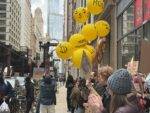
illustration by Alex Kostiw
This year’s IN>TIME festival provided Chicago with a number of thought-provoking and well-made time-based art works. Interestingly, many of the works were made by more than one artist.
Art history valorizes individual artists; as a result, collaborations are reflexively viewed with the same expectations. When we discuss “process-based art” in class or in criticism, process is considered a part of the art; but often, the process of collaboration is not central to the conversation. Our eyes either go directly to the product, or to the individual personas participating.
This mode of reception pushes aside the nature of artistic collaboration, and how separate a collaborative effort is from the individual practices of the artists making work together. I saw an example of inadequate treatment of collaboration during IN>TIME when I went to the two public events surrounding “The Data That We Breathe,” the University of Chicago’s (UC’s) Gray Center collaboration between Caroline Bergvall, Jennifer Scappettone, and Judd Morrissey.
For those who don’t know about her, it bears noting that Bergvall is a big deal. She is an excellent example of an international interdisciplinary artist, making work that blurs the borders of sound, performance, writing, digital, and installation art. Of French and Norwegian nationalities, her work often dismantles the boundaries of meaning through shifting and hybrid language, making way for raw sound and new meaning.
Bergvall joined other Mellon Collaborative Fellows Morrissey, a School of the Art Institute (SAIC) professor and internationally-known digital artist; and Scappettone, a UC professor, poet, and performance artist. They are working to create a collaboration that is slated to continue into the fall of 2016. Their motivating ideas are data, toxicity, and breath.
The premise is excellent, and to present this collaboration to an audience at the first event on January 27, the Gray Center organized presentations of each individual artist’s practice. Though all three are quite accomplished, it became apparent that first night that they had no clear idea how they were going to approach their work together, or what form it was going to take. The audience learned very little about how this collaboration was going to proceed.
This stands to reason, because they had only come together a week prior, and had a month ahead of them to create what would be seen at IN>TIME on February 28. The process would, it seemed, be explored through a class taught at UC. When I asked around, no presentation or discussion of methodology was made in that class, either.
The Gray Center prides itself on funding inquiry into art and scholarship, and to that end, showing a work in progress is in line with their mission. What they haven’t done with the “Data That We Breathe,” however, is give an opportunity for the audience to see the methodology of the collaboration behind the work.
Collaborations need time for the work to take initial form, for it to be negotiated among the collaborators, and for informed choices about the work to lead to the final product. This process takes at least a year if the artists are serious about the inquiry and methodology.
Bergvall, Morrissey, and Scappettone are clearly invested in both the inquiry and the collaboration. However, the Gray Center has scheduled their programming around this work to (once again) focus more on product removed from process, and less on understanding the work itself — which is the collaboration taking place — and the art coming out of that collaboration.
The piece presented at IN>TIME was a work-in-progress, and therefore cannot be examined as the final product. It also cannot be viewed as documentation of the collaboration, because the artists did not discuss or present documentation of their collaborative methodology when presenting the work.
The questions remain, then, how an audience should respond to the work shown so far, and how the Gray Center chooses to present works of art and scholarship made in this manner. There has to be a more considered way to approach a year-long collaboration besides hosting individual presentations and showing a work-in-progress one month in.
The Gray Center website has not posted any information about the future of “The Data That We Breathe,” though there was an announcement at the February 28 performance that another showing would take place this fall. If all an audience can see of a year-long collaboration is an initial work-in-progress after a month and possibly the final product, then we are once again asked to invest our attention in a product, not the process. This seems counter intuitive to a project aimed at collaboration and inquiry.





















